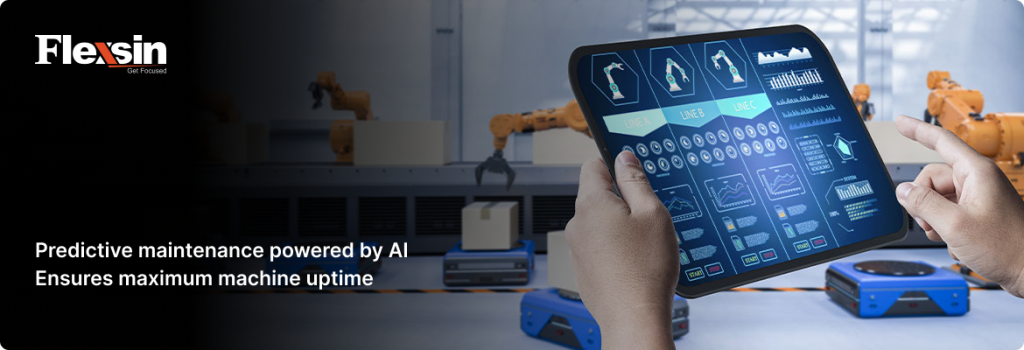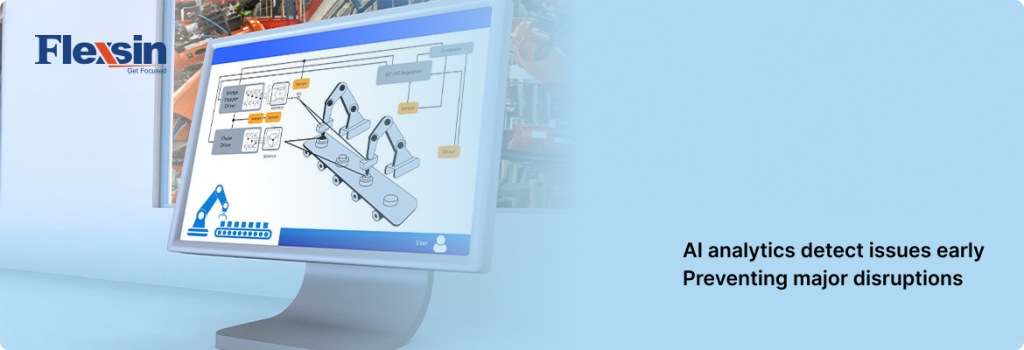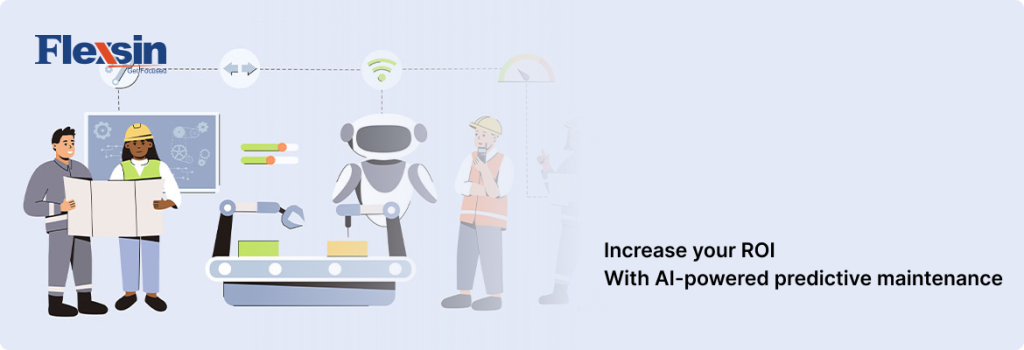Unexpected equipment failures can cost enterprises millions in lost productivity, safety risks, and emergency repair expenses. In sectors like manufacturing, energy, and transportation, downtime isn’t just a disruption-it’s a direct hit to revenue and reputation. Yet most organizations still struggle with traditional, reactive maintenance models that only respond once a breakdown has occurred.
This is where AI in predictive maintenance consulting services comes in. Instead of reacting to failures, AI anticipates them-helping businesses prevent costly downtime, extend equipment lifespan, and ensure safety improvements. But making AI predictive maintenance work in real-world enterprise environments requires more than just algorithms. It takes tailored consulting services that address integration, scalability, and ROI challenges head-on.
At Flexsin Technologies, our AI-driven predictive maintenance consulting ensures organizations don’t just deploy AI-they actually maximize the value of AI-assisted maintenance strategies with measurable business outcomes.
1. Use of AI in Predictive Maintenance
While the promise of predictive maintenance is clear, many businesses still fail to realize its full ROI due to customization gaps, integration hurdles, and limited visibility across assets. A consulting-driven approach solves these problems by aligning AI strategies with industry-specific needs.
Important Things to Know
For enterprises new to predictive maintenance, the biggest challenge is understanding where to start. Data exists across sensors, ERP systems, and Industrial IoT (IIoT) platforms, but without structure, it creates noise instead of insights.
Consulting experts bridge this gap by:
Identifying high-value assets where predictive maintenance will have the most immediate ROI.
Establishing data pipelines for machine health monitoring, anomaly detection, and failure prediction models.
Recommending fit-for-purpose AI maintenance services that scale without overwhelming operations.
This beginner-focused approach ensures businesses avoid costly pilot projects that never deliver results.
How AI in Predictive Maintenance Helps Businesses Save Money?
Predictive maintenance is often pitched as a cost saver, but consulting ensures those savings translate into real business impact. According to McKinsey, AI-driven predictive maintenance can reduce equipment downtime by up to 50% and cut maintenance costs by 40%.
Flexsin’s consulting services help enterprises:
Design failure prediction models that minimize unexpected shutdowns.
Optimize equipment lifecycle management, extending machine health beyond traditional limits.
Quantify predictive maintenance ROI with dashboards that track savings in real time.

AI detects issues early, so you can fix them before they impact operations
For B2B decision-makers, this isn’t just about cost savings-it’s about enabling greater productivity gains and faster conversions by ensuring operations run seamlessly.
Top Reasons for Using AI in Predictive Maintenance
With Industry 4.0 accelerating, predictive maintenance is no longer optional-it’s a growth enabler. Consulting services provide the strategic lens to:
Integrate predictive maintenance into digital transformation roadmaps.
Ensure scalable solutions that work across multiple facilities and geographies.
Support multi-platform SEO optimization by making enterprise data visible across Google, TikTok, YouTube, and even AI platforms like ChatGPT.
By aligning predictive maintenance with broader business strategies, consulting ensures enterprises not only eliminate downtime risk but also position themselves as AI-first organizations in their sector.
2. Overcoming Integration and Customization Challenges in Predictive Maintenance
Even though AI-driven predictive maintenance is proven to reduce downtime, enterprises often stumble when it comes to integrating solutions into existing operations. Off-the-shelf tools may detect anomalies, but they rarely align with the unique workflows, legacy systems, and compliance requirements of different industries. This is where AI in predictive maintenance consulting services demonstrate real value-by providing customized solutions that adapt AI models to business realities.
Why Integration with Legacy Systems Is a Barrier for Enterprises?
Many industrial facilities still rely on legacy ERP, SCADA, and CMMS systems that were not designed to support AI-assisted maintenance. Simply plugging in AI tools often leads to data silos or incomplete visibility.
Consulting services solve this by:
Conducting system audits to assess compatibility with Industrial IoT (IIoT) devices and sensors.
Designing integration pipelines that unify data from multiple sources into a centralized predictive maintenance platform.
Ensuring compliance with data security and privacy regulations, critical in sectors like healthcare and energy.
This integration-first approach guarantees that machine health monitoring becomes holistic, with all equipment data feeding into a single source of truth.
Customizing Predictive Maintenance for Industry-Specific Needs
Predictive maintenance challenges differ across industries.
For example:
Manufacturing struggles with high-speed machinery where even a few seconds of downtime can cost millions.
Oil & gas prioritizes safety improvements and risk mitigation in hazardous environments.
Transportation and logistics need real-time anomaly detection to keep fleets reliable and on schedule.
Flexsin’s consulting experts adapt predictive maintenance frameworks to these realities by:
Developing failure prediction models tuned for industry-specific equipment behavior.
Creating custom AI maintenance services that reflect regulatory, environmental, and operational contexts.
Designing dashboards that highlight predictive maintenance ROI in terms meaningful to each sector.
This customization ensures that predictive maintenance moves beyond theory and delivers measurable, industry-specific outcomes.
Scalability: Making Predictive Maintenance Work across Enterprises
Another major challenge businesses face is scalability. Running a predictive maintenance pilot on one machine is easy; extending it to hundreds of assets across multiple sites is far more complex.

Preventive action powered by AI keeps your equipment in top condition.
Flexsin’s AI-driven predictive maintenance consulting addresses scalability by:
Using cloud-native architectures to scale data processing for enterprise-wide deployment.
Enabling multi-site equipment lifecycle optimization through centralized dashboards.
Supporting continuous learning AI models that improve anomaly detection accuracy as more data is collected.
With scalability built-in, predictive maintenance evolves from a cost-saving pilot into a strategic enterprise capability that drives long-term productivity gains.
3. Strategic Benefits of AI in Predictive Maintenance
For enterprises, preventing equipment failures before they happen is no longer just an operational goal-it’s a strategic advantage. Businesses that leverage AI in predictive maintenance consulting services can not only reduce downtime risk but also achieve measurable ROI, safety improvements, and productivity gains.
Reducing Downtime Risk with AI-Driven Insights
Unexpected equipment failures cause cascading operational disruptions. Predictive maintenance powered by AI turns reactive processes into proactive strategies, enabling enterprises to:
Detect anomalies early using advanced machine learning algorithms.
Prioritize maintenance schedules based on equipment health and criticality.
Forecast potential failures with failure prediction models, minimizing unplanned downtime.
For example, a manufacturing client partnered with Flexsin to implement a custom AI maintenance service. Within six months, the enterprise reduced machine downtime by 45%, while gaining better visibility into asset performance.
Maximizing ROI through AI in Predictive Maintenance
Investing in predictive maintenance is only valuable if it drives real business outcomes. Consulting services ensure ROI is measurable by:
Implementing equipment lifecycle optimization strategies that extend asset longevity.
Tracking productivity gains via AI dashboards that quantify cost avoidance and operational efficiency.
Aligning predictive maintenance initiatives with financial KPIs, such as maintenance cost reductions and energy savings.
According to industry research, enterprises that deploy AI-assisted maintenance with expert consulting see up to 40% reduction in maintenance costs and a 50% improvement in equipment uptime.

Boost your ROI with AI solutions that forecast equipment failures before they happen
Real-World Use Cases Demonstrating AI Impact
1. Energy Sector:
AI predictive models monitored transformers and turbines in real-time. By identifying voltage fluctuations early, unplanned outages were reduced by 30%, improving reliability across multiple grids.
2. Transportation & Logistics:
Fleet operators used anomaly detection algorithms to predict engine and brake failures. The AI-assisted maintenance strategy reduced vehicle downtime and improved delivery punctuality.
3. Industrial Manufacturing:
By integrating IIoT sensors and machine learning, predictive maintenance minimized machine stoppages, optimized repair schedules, and increased throughput across production lines.
Flexsin’s consulting approach ensures these strategies are customized, integrated, and scalable, aligning with enterprise objectives and regulatory requirements.
Taking the Next Step toward AI-Powered Predictive Maintenance
Adopting AI in predictive maintenance consulting services transforms maintenance from a reactive cost center into a strategic growth driver. Enterprises can now prevent equipment failures before they happen, reduce downtime risk, optimize assets, and achieve measurable ROI.
Flexsin has deployed AI driven failure forecasting platforms for Jamis Bikes, Sadirat, Daikin, and many more, that slash unplanned downtime, extend asset life and boost operational throughput in industrial manufacturing.
Actionable Next Step:
Start your AI in predictive maintenance consulting services transformation today with Flexsin Technologies and unlock the full potential of predictive maintenance. Learn more about our custom AI maintenance solutions and connect with us on LinkedIn for industry insights and updates.


 Munesh Singh
Munesh Singh